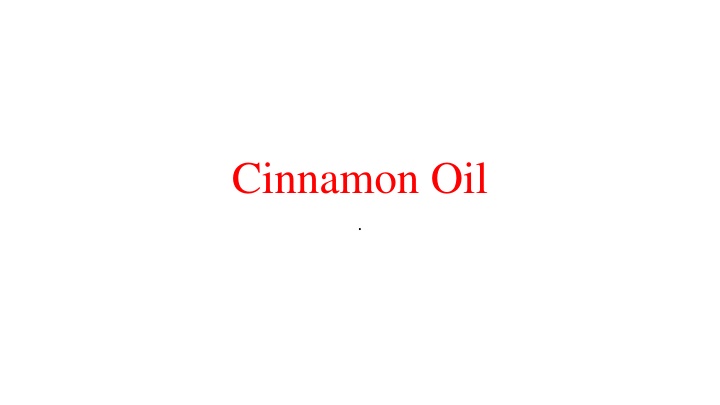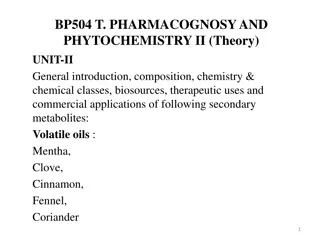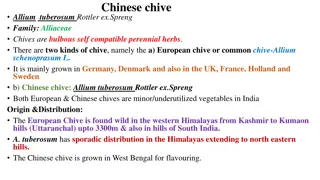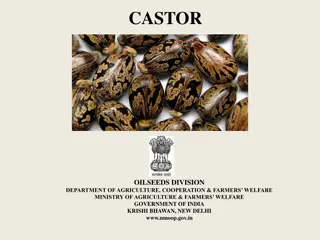Comprehensive Guide to Cinnamon Oil: Cultivation, Properties, and Uses
Cinnamon oil, extracted from the bark of Cinnamomum trees, is a valuable ingredient known for its aromatic and medicinal properties. This guide covers the cultivation process, macroscopic characteristics, chemical constituents, and uses of cinnamon oil. From its geographical sources to chemical tests and applications as a flavoring agent, spice, and more, this comprehensive overview provides insights into this versatile essential oil.
Download Presentation

Please find below an Image/Link to download the presentation.
The content on the website is provided AS IS for your information and personal use only. It may not be sold, licensed, or shared on other websites without obtaining consent from the author.If you encounter any issues during the download, it is possible that the publisher has removed the file from their server.
You are allowed to download the files provided on this website for personal or commercial use, subject to the condition that they are used lawfully. All files are the property of their respective owners.
The content on the website is provided AS IS for your information and personal use only. It may not be sold, licensed, or shared on other websites without obtaining consent from the author.
E N D
Presentation Transcript
Cinnamon Oil Synonym: Cinnamon bark; Kalmi-Dalchini, Ceylon cinnamon Biological Source: Dried inner bark of the shoots of coppiced trees of Cinnamomum zeylanicum , (Syn. Cinnamomum verum ), family Lauraceae. Should not contain < than 1.0% of volatile oil. Geographical Source: evergreen tree of tropical area, native of Sri Lanka and Malabar coast of India. Also found in Jamaica and Brazil. Most of the world requirements met by Sri Lanka & hence true cinnamon is known as Sri Lanka cinnamon. 2
Cultivation Cinnamon Oil Propagated by planting the cuttings and layers Commercially, propagated by seed Needs sandy or siliconous soils, humus. Altitude 800 to 1000 metres. Annual rainfall of 200 - 250 cm. Seeds sown prepared nursery beds in June and July, distance of 10 cm, covered with small layer of soil and watered properly. 20 days for germination of seeds. allowed to grow for about 10 12 M Transplantation-in Oct./Nov. or in rainy season, distance of 2 meters b/w 2 plants. Shades provided with the pendals of coconut leaves. weeded 2 - 4 times in a year. Manured with 100 g (NH4)2SO4 & superphosphate as/ age. two equal doses, 1st in monsoon & 2nd in Oc-Nov. 3
Macroscopy Macroscopic Characters: Colour - outer surface: dull yellowish brown, inner surface: dark yellowish-brown. Odour Fragrant Shape-compound quills Size - 1m L, 1cm D. Bark thickness approx. 0.5 mm. Taste Aromatic & sweet followed by warm sensation. Fracture Splintery Outer surface-marked by wavy longitudinal striations with small holes of scars left by the branches. Inner surfaces also shows the longitudinal striations. Bark is free of cork. 4
OH Chemical Constituents Contains 0.5 - 1.0% of volatile oil, 1.2% of tannins (phlobatannins), mucilage, calcium oxalate, starch & sweet substance known as mannitol. The volatile oil is the active constituent of the drug. Light yellow (when freshly distilled) in color, changes to red on storage. Cinnamon oil contains 60 70% of cinnamaldehyde, 5 10% eugenol, benzaldehyde, cuminaldehyde & other terpenes like phellandrene, pinene, cymene, caryophyllene, etc. Cinnamon oil is yellow to red in color, sp. gr. 1.00 - 1.030; optical rotation 0 to 2; and refractive index 1.562 - 1.582 . OCH3 CH2 CH CH2 5
Chemical Tests and Uses Chemical Test: drop of volatile oil + drop of FeCl3 gives pale green color. FeCl3 + cinnamic aldehyde gives brown color & eugenol gives blue color, resulting in the formation of pale green colour. In Cassia oil brown color is obtained, as it contains only cinnamic aldehyde. Uses: Carminative, stomachic and mild astringent, flavouring agent, stimulant, an aromatic, and antiseptic, as a spice & condiment, & in the preparation of candy, dentrifices & perfumes. 6
Substituents & aduterants Jungle cinnamon: wild growing trees, dark in color, less aromatic than the cultivated trees, & slightly bitter. Cinnamon chips: Pieces of untrimmed bark, distinguished from genuine drug by presence of abundant cork cells & poor yield to 90 % alcohol. Cultivated Saigon cinnamon: bark of trees of Cinnamomum loureirii (Lauraceae). exported from port of Saigon. It is in China and Japan. Bark greyish brown in color, light patches & sweet taste. Quills are 30 4 0.7 cm, unpeeled & Contain 2.5& volatile oil. Java Cinnamon: Cinnamomum burmanii (Lauraceae). less aromatic, peeled & found in form of double quills. 7
Substituents & aduterants Histologically, medullary rays contain small tubular crystals of calcium oxalate, not found in C. zeylanicum. It contains about 75 % of cinnamaldehyde in the oil. It also gives poor yield to 90 % alcohol as compared to Sri Lanka cinnamon. Storage: well closed containers in cool place, away from light. 8























